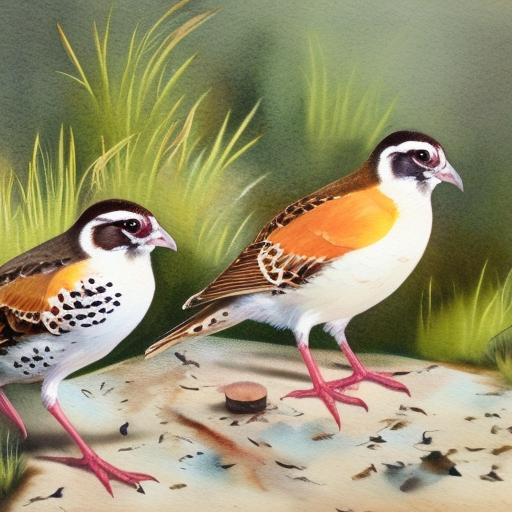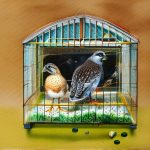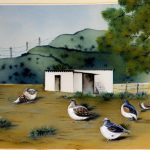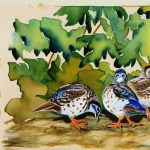Quail finches are small, colorful birds that are popular among bird enthusiasts for their beautiful plumage and melodious songs. Breeding quail finches can be a rewarding and enjoyable experience for bird lovers, as it allows them to witness the fascinating process of new life being brought into the world. Before embarking on the journey of quail finch breeding, it is important to understand the basics of their breeding behavior, as well as the necessary steps to create a suitable breeding environment. This article will provide a comprehensive guide to quail finch breeding, including tips for selecting the right breeding pair, creating the ideal breeding environment, understanding quail finch breeding behavior, caring for quail finch chicks, and addressing common challenges that may arise during the breeding process.
Key Takeaways
- Quail finch breeding requires careful selection of the right breeding pair to ensure healthy offspring.
- Creating the ideal breeding environment involves providing a spacious cage with nesting materials and a balanced diet.
- Understanding quail finch breeding behavior is essential for successful breeding, including recognizing courtship displays and nesting habits.
- Caring for quail finch chicks involves providing a warm and safe environment, as well as a diet high in protein for healthy growth.
- Common challenges in quail finch breeding include egg binding, infertility, and chick mortality, which require prompt attention and care.
- Tips for successful quail finch breeding include regular monitoring of breeding pairs, providing a varied diet, and seeking advice from experienced breeders or avian veterinarians.
Selecting the Right Breeding Pair
Selecting the right breeding pair is crucial for successful quail finch breeding. When choosing a breeding pair, it is important to consider factors such as age, health, and genetic diversity. Ideally, the breeding pair should be mature, healthy, and unrelated to each other to prevent inbreeding. It is also important to observe the behavior of potential breeding pairs to ensure compatibility and minimize the risk of aggression or conflict. Additionally, it is recommended to consult with experienced breeders or avian veterinarians to obtain advice on selecting the best breeding pair for your specific breeding goals. By carefully selecting the right breeding pair, you can increase the likelihood of producing healthy and vibrant quail finch chicks.
Once you have selected a breeding pair, it is important to provide them with a suitable breeding environment that meets their specific needs. This includes providing a spacious and secure breeding cage or aviary that allows the birds to build nests and engage in courtship behaviors. The breeding environment should also be equipped with appropriate nesting materials, such as soft nesting fibers or grass, to encourage the female quail finch to lay eggs. Additionally, it is important to ensure that the breeding environment is kept at an appropriate temperature and humidity level to promote successful breeding and chick development. By creating an ideal breeding environment, you can help your quail finches feel comfortable and secure, which can in turn enhance their breeding success.
Creating the Ideal Breeding Environment
Creating the ideal breeding environment for quail finches is essential for successful breeding outcomes. Quail finches are social birds that thrive in spacious aviaries or cages with plenty of room for flying and nesting. When setting up the breeding environment, it is important to provide natural perches and branches for the birds to perch on and explore. Additionally, it is important to include nesting boxes or baskets filled with soft nesting materials to encourage the female quail finch to lay eggs. The nesting boxes should be placed in a quiet and secluded area of the aviary to provide the breeding pair with privacy and security during the nesting and incubation process.
In addition to providing suitable nesting materials, it is important to ensure that the breeding environment is kept at an appropriate temperature and humidity level. Quail finches thrive in warm and humid conditions, so it is important to monitor the temperature and humidity levels in the aviary or cage regularly. Using a thermometer and hygrometer can help you maintain optimal conditions for breeding and chick development. It is also important to provide a balanced diet that includes a variety of seeds, fresh fruits, and vegetables to ensure that the breeding pair receives essential nutrients for reproductive success. By creating an ideal breeding environment that meets the specific needs of quail finches, you can help promote successful breeding and chick rearing.
Understanding Quail Finch Breeding Behavior
Understanding quail finch breeding behavior is essential for successful breeding outcomes. Quail finches are monogamous birds that form strong pair bonds with their mates. During the breeding season, male quail finches will engage in courtship displays to attract a mate, such as singing, fluttering their wings, and offering food to the female. Once a pair bond is formed, the female will begin building a nest using nesting materials provided in the breeding environment. Female quail finches typically lay a clutch of 4-6 eggs, which they will incubate for approximately 12-14 days before hatching.
After the eggs hatch, both parents will take turns feeding and caring for the chicks until they are independent. It is important to observe and understand the natural behaviors of quail finches during the breeding process to ensure that they have everything they need for successful reproduction. By understanding quail finch breeding behavior, you can provide appropriate support and care for the breeding pair and their chicks, which can ultimately lead to a positive breeding experience.
Caring for Quail Finch Chicks
Caring for quail finch chicks requires attention to detail and a nurturing approach to ensure their health and well-being. Once the chicks hatch, it is important to provide them with a warm and secure nesting area within the aviary or cage. The nesting area should be equipped with soft bedding material to keep the chicks comfortable and protected. Additionally, it is important to provide a balanced diet that includes high-quality chick food, as well as small insects and egg food to meet their nutritional needs.
It is also important to monitor the chicks closely to ensure that they are growing and developing at a healthy rate. Regularly weighing the chicks can help you track their growth progress and identify any potential health issues early on. Additionally, it is important to observe the behavior of the parent birds to ensure that they are providing adequate care and nutrition to the chicks. If necessary, you may need to intervene by hand-feeding or providing supplemental nutrition to ensure the chicks’ well-being. By providing attentive care and support to quail finch chicks, you can help them thrive and develop into healthy adult birds.
Common Challenges in Quail Finch Breeding
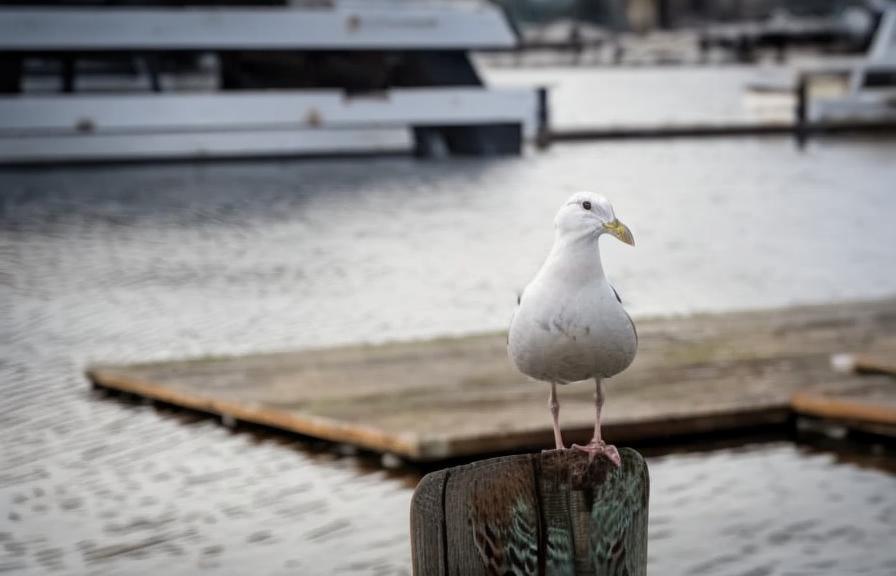
While quail finch breeding can be a rewarding experience, it also comes with its own set of challenges that breeders may encounter. One common challenge is egg binding, which occurs when a female quail finch is unable to lay an egg due to various health issues or nutritional deficiencies. Egg binding can be life-threatening if not addressed promptly, so it is important to monitor the female closely during the egg-laying process and seek veterinary assistance if necessary.
Another common challenge in quail finch breeding is chick mortality, which can occur due to genetic abnormalities, inadequate nutrition, or parental neglect. It is important to be prepared for potential chick mortality and have a plan in place for providing appropriate care and support to ensure the survival of healthy chicks. Additionally, maintaining optimal hygiene in the breeding environment is essential for preventing the spread of diseases and parasites that can affect the health of quail finches and their chicks.
Tips for Successful Quail Finch Breeding
To ensure successful quail finch breeding outcomes, there are several tips that breeders can follow to enhance their breeding experience. First and foremost, it is important to conduct thorough research on quail finch breeding behavior and requirements before embarking on the breeding process. This includes understanding their natural habitat, diet, reproductive behaviors, and potential health issues that may arise during breeding.
Additionally, it is important to provide a balanced diet that meets the nutritional needs of quail finches throughout the breeding process. This includes offering a variety of seeds, fresh fruits, vegetables, and high-quality protein sources such as egg food or small insects. Providing a nutritious diet can help support reproductive success and chick development.
Furthermore, regular monitoring of the breeding pair and their chicks is essential for identifying any potential health issues or challenges early on. This includes observing their behavior, weight monitoring, and seeking veterinary assistance if necessary.
Lastly, creating a supportive and stress-free environment for quail finches can contribute to successful breeding outcomes. This includes providing ample space for flying and nesting, as well as minimizing disturbances in their environment during the breeding process.
In conclusion, quail finch breeding can be a fulfilling experience for bird enthusiasts who are passionate about aviculture. By selecting the right breeding pair, creating an ideal breeding environment, understanding quail finch breeding behavior, caring for quail finch chicks, addressing common challenges, and following tips for successful breeding, breeders can enhance their chances of producing healthy and vibrant quail finch offspring. With dedication, patience, and knowledge of quail finch husbandry practices, breeders can enjoy the wonders of witnessing new life being brought into the world through successful quail finch breeding endeavors.
If you’re interested in quail finch breeding, you might also want to learn about the mating season for turkeys. Understanding the breeding behaviors of different poultry species can provide valuable insights into creating optimal breeding environments. Check out this informative article on mating season for turkeys to expand your knowledge of poultry breeding practices.
FAQs
What is quail finch breeding?
Quail finch breeding refers to the process of breeding and raising quail finches, a small species of bird native to Australia and New Guinea. This process involves providing the necessary care, housing, and nutrition to encourage successful breeding and the health of the birds.
What do quail finches eat?
Quail finches primarily eat a diet of seeds, including millet, canary seed, and grass seeds. They also benefit from a variety of fresh fruits and vegetables, as well as small insects and mealworms for added protein.
How do you encourage quail finch breeding?
To encourage quail finch breeding, it is important to provide a suitable nesting area, a balanced diet, and a stress-free environment. Additionally, ensuring that the birds have access to clean water and ample space for exercise and social interaction can also encourage breeding behavior.
What is the breeding season for quail finches?
Quail finches typically breed during the warmer months, with the breeding season typically occurring from spring to early autumn. It is important to provide the appropriate conditions and nesting materials during this time to support successful breeding.
How long does it take for quail finch eggs to hatch?
Quail finch eggs typically take around 12-14 days to hatch. It is important to provide a stable and warm environment for the eggs during this time to ensure the health and development of the chicks.
What is the average lifespan of quail finches?
Quail finches have an average lifespan of 5-7 years when kept in captivity and provided with proper care and nutrition. However, their lifespan can vary based on genetics, environment, and overall health.
Meet Walter, the feathered-friend fanatic of Florida! Nestled in the sunshine state, Walter struts through life with his feathered companions, clucking his way to happiness. With a coop that’s fancier than a five-star hotel, he’s the Don Juan of the chicken world. When he’s not teaching his hens to do the cha-cha, you’ll find him in a heated debate with his prized rooster, Sir Clucks-a-Lot. Walter’s poultry passion is no yolk; he’s the sunny-side-up guy you never knew you needed in your flock of friends!

